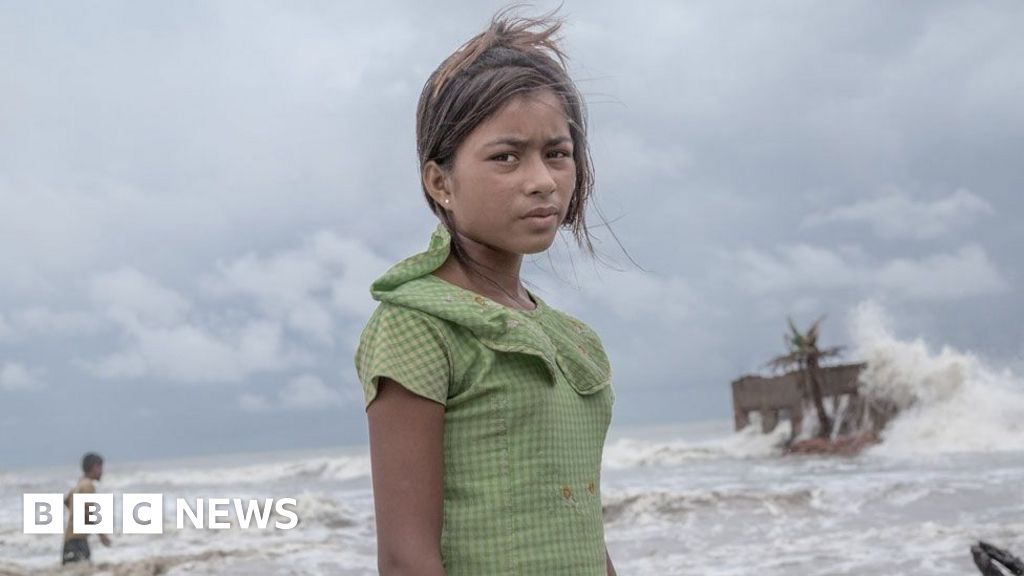Supratim Bhattacharjee wins this year’s Mangrove Photography Award for his photo of a little girl after a devastating storm in Frazerganj, India’s Sundarbans state champion.
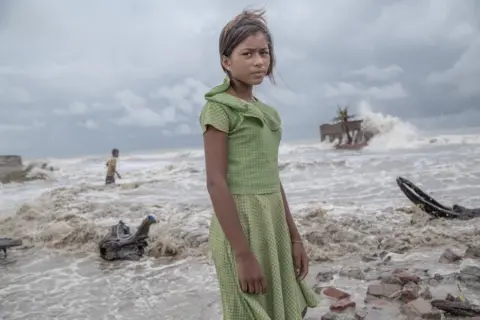 Suprati Bhattacharjee
Suprati Bhattacharjeerun by mangrove action projectThe competition, now in its tenth year, aims to showcase the relationship between wildlife, coastal communities and mangroves, as well as the fragility of these unique ecosystems, both above and below the waterline.
Mr. Bhattacharjee’s winning entry, titled “The Sunken Sundarbans,” shows Pallavi standing in front of her home and tea shop, which was destroyed by the sea during a storm.
“During that devastating period, I observed her strong face and calm personality,” Mr. Bhattacharjee said.
“Children are the ones who suffer the most.”
Situated in the Bay of Bengal, the Sundarbans are the largest mangrove forests in the world.
“[The winning] The image asks a thousand questions while connecting you to the girl’s heart,” said competition judge Dhritiman Mukherjee.
“Her vulnerability exposes the full impacts of climate change and sea level rise experienced by many coastal communities.”
Mangroves are an important protection against climate change, with one acre (4,000 square meters) of mangroves absorbing nearly the same amount of carbon dioxide as one acre of the Amazon rainforest.
Forests also protect shorelines from erosion as severe storms become more frequent.
“Conservation as a story is a complex story,” said Morgan Heim, another judge.
“No matter what language we use, photography has the power to help us accept and feel these stories. Every time I see this photography, I think, there is still hope.”
Judge Christian Ziegler added: “[In the competition] There are many fascinating stories about life in the mangroves, from scientific insights to the restoration of the ecosystem and the difficult conditions people face.
Below is a selection of the winning photos from the seven competition categories, along with descriptions from the photographers.
Mangroves and People Award Winner: Mud Bath Ritual, by Johannes Panji Christo, Indonesia
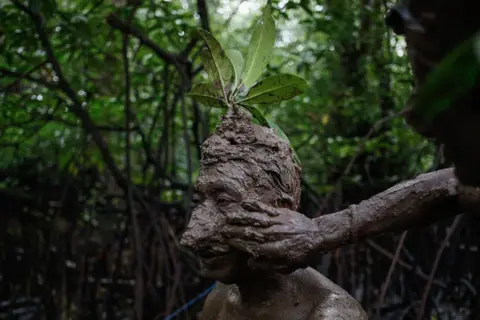 Johannes Pange Christo
Johannes Pange ChristoMen, women and children in Kedonganan village outside the town of Denpasar on the Indonesian island of Bali wear sarongs and traditional headdresses and collect soil from mangrove forests.
They wrap themselves up as part of a purification ritual called Mebuug Buugan, where people pray for thanksgiving and the fertility of the earth.
Mangroves and People, Highly Commended: The Sunken Sundarbans II, by Supratim Bhattacharjee, India
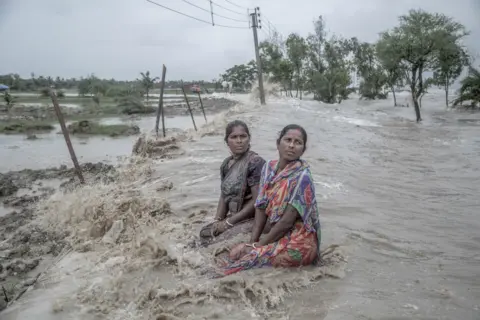 Suprati Bhattacharjee
Suprati BhattacharjeeThe Sundarbans straddle the border of India and Bangladesh… [and] It is famous for its rich forest resources, which local people depend on for income.
But rampant deforestation coupled with increasingly severe storms is exacerbating food and water shortages, reducing agricultural productivity and soil quality, and turning local communities into climate refugees.
Mangroves and Landscape Award Winner: “Natural Ribbons” by Ammar Alsayed Ahmed, United Arab Emirates
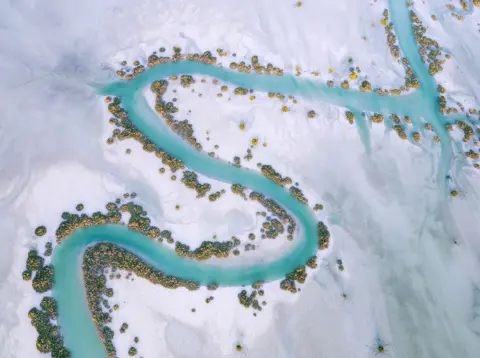 Ammar Alsayed Ahmed
Ammar Alsayed AhmedThis peaceful view is meditative as gentle water flows through the heart of the mangrove forest.
Intertwining tree roots form intricate patterns, creating a natural tapestry that harmonizes with the flow of water.
Mangroves and Landscapes, Highly Commended: Constructing Sunsets, Vladimir Borzykin, India
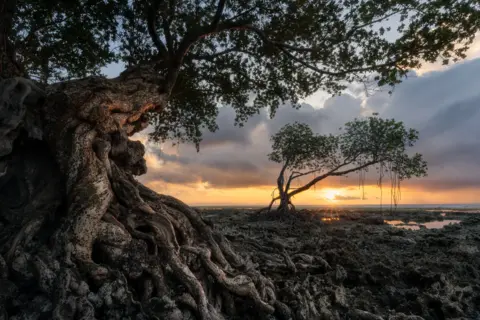 Vladimir Bozhkin
Vladimir BozhkinOn the rugged coast of Neil Island (Shaheed Dweep) in the Andaman Islands, the tide recedes away from the shore, exposing extremely sharp rocks.
Mangroves and Wildlife Award Winner: Mud Ring Feeding, by Mark Ian Cook, USA
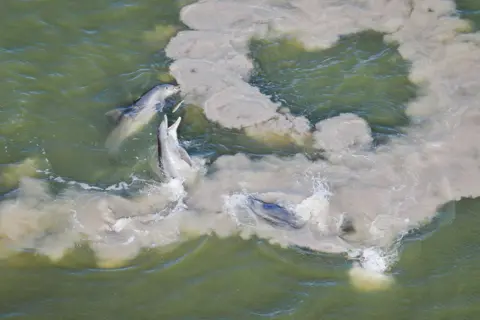 Mark Ian Cook
Mark Ian CookMud ring feeding is a unique fishing behavior used by bottlenose dolphins that live in the shallows of mangrove bays in Florida Bay and some other locations in the Caribbean.
When a school of mullet is spotted, one of the dolphins in the pod surrounds the fish, kicking up the sediment with its tail and surrounding the fish in a tightening spiral of silty feathers.
Dolphins have an extraordinary ability to know where fish will jump and catch them out of the air as they try to escape.
Mangroves and Wildlife, Highly Commended: The Fire Within, Javier Orozco, Mexico
 Javier Orozco
Javier OrozcoPhotographer Javier Orozco comes face to face with a crocodile at the Elcora Crocodile Sanctuary in Bucerías, Banderas Bay, Mexico.
Over the past 40 years, Banderas Bay has lost more than 80% of its wetlands to urban expansion.
This crocodile sanctuary is a non-profit organization located next to a small lagoon. The surrounding area has been taken over by shopping malls, restaurants and apartments.
Mangroves and the Threat Winner: “Mangrove Walls Broken” by Dipayan Bose, India
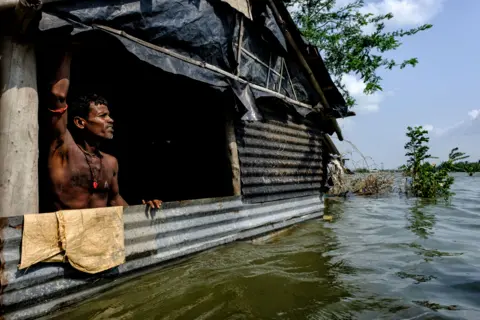 Deepayan Bose
Deepayan BoseRiver banks in the Sundarbans region of West Bengal, India, have been breached by high tides due to recurring tropical cyclones and rising sea levels in the Bay of Bengal.
As a result, homes and farms were flooded, fisheries were destroyed by seawater, and people were forced to relocate.
This villager lost all his family property in the flood.
Mangroves and Threats, Highly Commended: “Ghost Network Love”, by Daphne Wong, Hong Kong
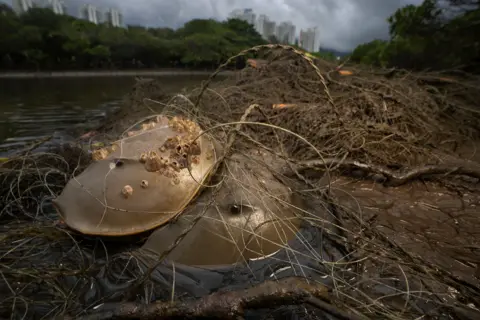 Daphne Huang
Daphne HuangThe male horseshoe crab clings to the female’s back and is responsible for reproduction.
They move as the tide rises, looking for a suitable place to lay their eggs. But when they reach the mangroves, they are tangled in a huge ghost web.
If no one rescues them in time, they will eventually die from long-term exposure.
In Hong Kong and across Asia, abandoned fishing nets wash up on shores and in mangroves, entangling many creatures.
Mangroves and Underwater Champions: “Guardians of the Mangroves” by Olivier Clement, Bahamas
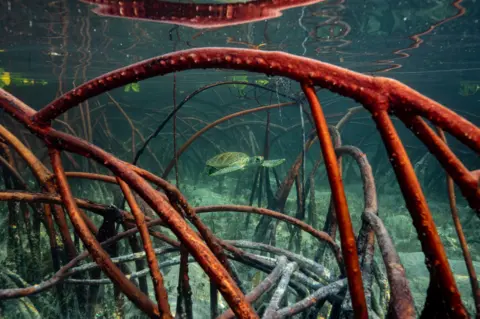 Olivier Clement
Olivier ClementA sea turtle gracefully navigates the maze of mangrove roots in search of shelter for the night.
At high tide, water eats away at tree roots, turning the space into a haven for marine life to seek shelter and safety.
Mangroves and Underwater, Highly Commended: Kakaban Mangroves, Purwanto Nugroho, Indonesia
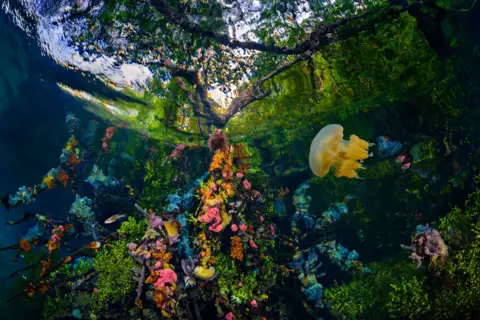 Puwanto Nugroho
Puwanto NugrohoMangroves act as natural filters, removing most pollutants before they reach the ocean.
Soil and mangrove biomass have a significant ability to store atmospheric carbon, helping to reduce carbon dioxide concentrations in the air.
Mangroves’ complex root systems also help bind soil and sediment, reduce erosion, and protect against damage from waves and currents.
Mangroves and Conservation Story Winner: Symbiosis, by Giacomo d’Orlando, Indonesia
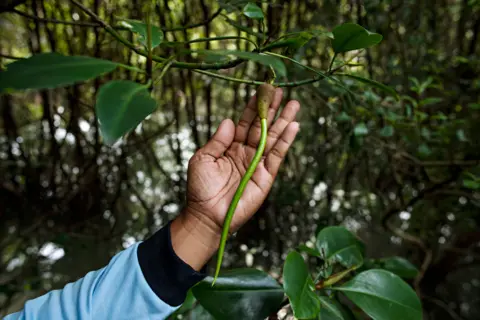 orlando james
orlando jamesIn Indonesia’s Demak district, the coastline has been severely eroded and the mangroves that once protected the coast have been cut down and replaced with aquaculture ponds. As a result, the sea is literally swallowing people’s homes.
[Demak’s residents] People realized that the only solution was to restore the ecosystem by replanting cleared mangroves.
Mangroves and Conservation Stories, Runner-up: Together, by Raj Hassanaly, Madagascar
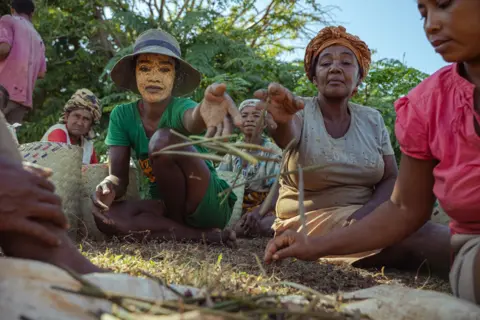 Raj Hassanali
Raj HassanaliAs mangroves are cleared, it becomes increasingly difficult for the region to fish, crab, and protect against climate change and violent cyclones.
Bôndy is a private company dedicated to ecosystem restoration, working with local communities to restore mangroves in the rural commune of Mahajanga, Madagascar.
Always smiling and in good spirits, they travel together through the mangroves and revitalize large tracts of remote land.
Young Mangrove Photographer of the Year Award Winner: “Mangrove at Night”, Nicholas Alexander Hess, Australia
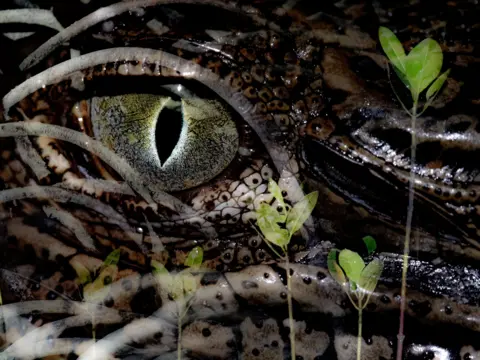 Nicholas Alexander Hess
Nicholas Alexander HessWhen I encountered this young saltwater crocodile at low tide in the mangroves, I wanted to capture more than just this young saltwater crocodile.
I used the multiple exposure mode in my camera to overlay layers onto the image of the alligator’s eyes to capture more of the scene without sacrificing eye detail.
The image gives a slightly unsettling feeling, much like one would experience in a mangrove, not knowing what predators might be lurking nearby, hidden within the dense network of mangroves.

